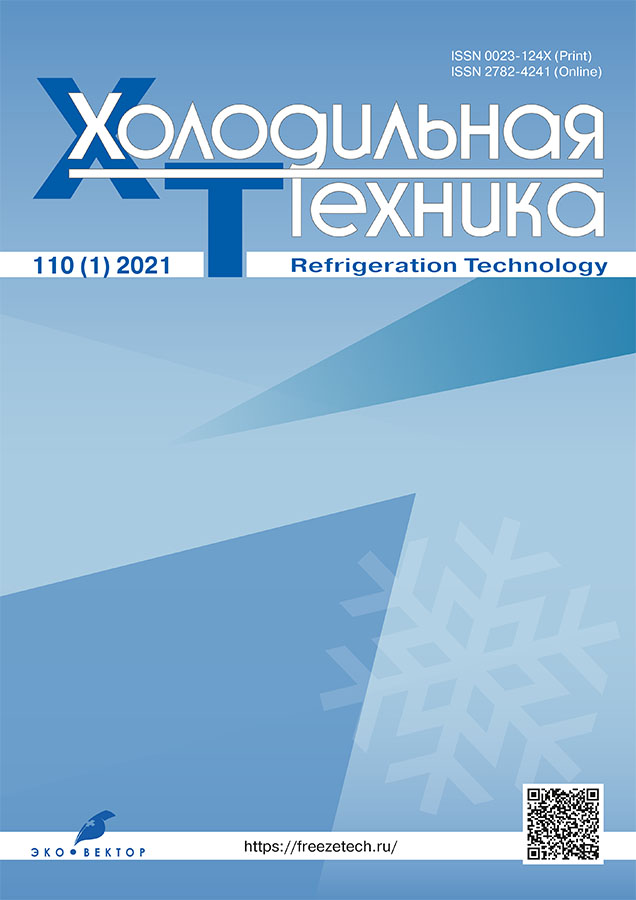Membrane drying of gases: opportunities and energy costs
- Authors: Levin E.V.1
-
Affiliations:
- Research Institute of Building Physics of the Russian Academy architecture and building Sciences
- Issue: Vol 110, No 1 (2021)
- Pages: 31-39
- Section: Original Study Articles
- URL: https://freezetech.ru/0023-124X/article/view/106897
- DOI: https://doi.org/10.17816/RF106897
- ID: 106897
Cite item
Abstract
BACKGROUND: Gas drying is widely used in many applications of science, technology and industry: high-purity gas media (microelectronics), and its methods are constantly being improved. One of them, membrane separation of gases, although considered as one of the most promising, is currently understudied.
AIM: The purpose of this work is to show the possibilities of the membrane gas separation method when it is used for drying compressed gases.
METHODS: The results of the study of the drying of compressed gases were obtained using the membrane method of gas separation.
CONCLUSIONS: The dependence of the degree of drying (dew point temperature) on such parameters of the gas separation process as the relative pressure drop across the membrane, the permeability and selectivity of the membrane for water vapor, the value of the working pressure and the value of the dried gas flow per unit area of the membrane is shown. It is shown that, with the help of membrane gas separation, drying can be performed to a dew point temperature of –100 ˚С and below. On the example of drying air and methane, the conditions are given under which membrane drying can be energetically more profitable compared to drying by cooling.
Full Text
About the authors
Evgeniy V. Levin
Research Institute of Building Physics of the Russian Academy architecture and building Sciences
Author for correspondence.
Email: aqwsrv@list.ru
SPIN-code: 7051-2374
Cand. (Phys.-Math.) Sci., Principal Researcher
Russian Federation, MoscowReferences
- Devjatyh GG, Elliev JuI. Vvedenie v teoriju glubokoj ochistki veshhestv. Moscow: Nauka; 1981. (In Russ.).
- Okonskij IS, Osokin AA, Fedjukov JuS. Processy i apparaty kislorodnogo i kriogennogo proizvodstva. Moscow: Mashinostroenie; 1985. (In Russ.).
- Mulder M. Vvedenie v membrannuju tehnologiju. Moscow: Mir; 1999. (In Russ.).
- Laguncov NI, Kurchatov IM, Karaseva MD, et al. Ocenka jeffektivnosti primenenija membrannyh tehnologij dlja izvlechenija gelija iz prirodnogo gaza pri povyshennyh davlenijah. Membrany i membrannye tehnologii. 2014;4(4):272–272. (In Russ.).
- Ohlrogge K, Peinemann K-V, Wind J, Behling P-D. Membranes, modules and membrane apparatus for vapor recovery. Proc. Int. Congr. on Membranes and Membrane Proc. ICOM’ 90: Abstracts / Chicaco. 1990:437–439.
- Laguntsov NI, Kurchatov IM, Karaseva MD, et al. Natural gas drying and cleaning of carbon dioxide by membrane gas separation. Petroleum Chemistry. 2017;57(2):132–138.
- Laguncov NI, Kagramanov GG, Kurchatov IM, et al. Osushka i ochistka prirodnogo gaza ot dioksida ugleroda metodom membrannogo gazorazdelenija. Membrany i membrannye tehnologii. 2017:7(1):20–27. (In Russ.).
- Mullahmetova LI, Cherkasova EI. Poputnyj neftjanoj gaz: podgotovka, transportirovka i pererabotka. Vestnik Kazanskogo tehnologicheskogo universiteta. 2015;18(19):83–90.
- Roberts DL, Ching GD. Recovery of freon gases with silicone rubber membranes. Ind. Eng. Chem. Process Des. Dev. 1986;25(4):971–973. (In Russ.).
- Vorotyncev VM, Drozdov PN, Nosyrev SA, et al. Glubokaja ochistka gazov ot primesi vody s pomoshh’ju perftorirovannyh sul’fokationitovyh membran. Vysokochistye veshhestva. 1994;(6):5–11. (In Russ.).
- Vorotyncev VM, Drozdov PN, Kirillov JuP. Glubokaja ochistka argona, germana i gelija ot vody metodom membrannogo gazorazdelenija. Vseros. nauch. konf. Membrany-2001: tezisy dokladov. Moscow; 2001:116.
- Sengupta A, Sirkar КК. Membrane gas separation. Progr. Filtr. Separ. 1986;(4):289–415. (In Russ.).
- Gruzdev E.B. Chislennoe issledovanie processov membrannogo razdelenija dvuh- i mnogokomponentnyh gazovyh smesej [dissertation] Moscow; 1988. (In Russ.).
- Gruzdev EB, Laguncov NI, Nikolaev BI, et al. Raschet razdelenija mnogokomponentnyh gazovyh smesej v membrannyh jelementah. Teoreticheskie osnovy himicheskoj tehnologii. 1986;20(2):157–163. (In Russ.).
- Laguncov NI, Talanceva EV, Tepljakov VV. Optimizacija gazorazdelitel’nyh recirkuljacionnyh membrannyh ustanovok. Teoreticheskie osnovy himicheskoj tehnologii. 2002;36(2):170–176. (In Russ.).
- Laguntsov NI, Tikhonov SN, Karaseva MD, et al. Mathematical modelling and numerical study of recirculation membrane and membrane-refrigerated systems of compressed air dehydration. Journal of Physics, Conference Series. 2019, p. 042042.
- Gruzdev EB, Ezhov VK, Kozhevnikov VYu. Gas separation in a recycle membrane cell. Theoretical Foundations of Chemical Engineering. 1989;23(4):538–543.
Supplementary files











